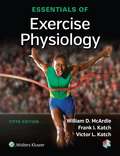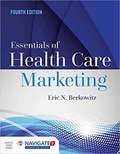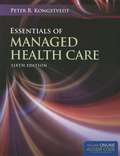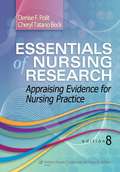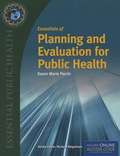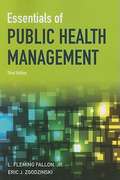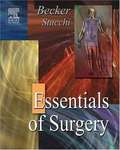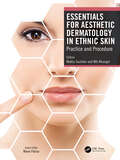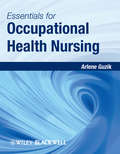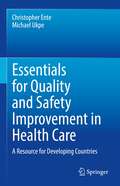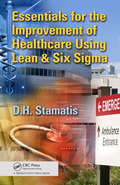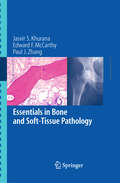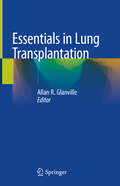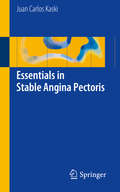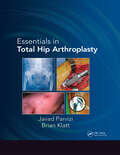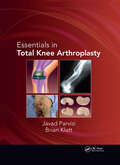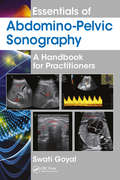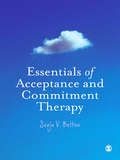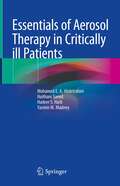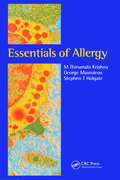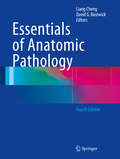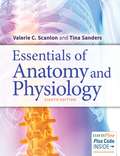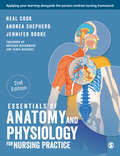- Table View
- List View
Essentials Of Exercise Physiology
by William D. Mcardle Frank I. Katch Victor L. KatchHelp your students succeed in the course and their future careers with this Fifth Edition of the briefer version of the best-selling McArdle Exercise Physiology text. The book emphasizes nutrition as the foundation of exercise and uses a new student-friendly magazine-style design, hallmark pedagogy, and an engaging writing style to make exercise physiology interesting and understandable for today's undergraduate students. Featuring updates in every section that reflect the latest trends and research in the field, Essentials of Exercise Physiology helps students develop a deep understanding of the interrelationships among energy intake, energy transfer during exercise, and the related physiologic systems. As they progress through the book, students also master the how-tos of applying key concepts to enhance exercise training, athletic performance, and health. In addition, the Fifth Edition includes a suite of instructor and student resources designed to save you time and help your students succeed. Student Resources: An online Interactive Question Bank with study and quiz options helps students master the content of the course. Supplemental documentation relevant to the field includes The Internet and Exercise Physiology, Surgeon General's Vision for Health Fit Nation 2010, and a Guide to Reliable Supplemental Information Sources. A list of Frequently Cited Journals in Exercise Physiology enables students to increase their understanding of topics of interest. Animations of key exercise physiology concepts selected by reviewers help students understand complex processes. Instructor Resources: PowerPoint presentations make it easy to integrate the textbook with your students' classroom experience via either handouts or slide shows. A complete image bank enhances lecture and exam preparation. A robust test generator helps you put together tests that assess your students' understanding.
Essentials Of Health Care Marketing
by Eric N. BerkowitzNew Fifth Edition of Essentials of Health Care Marketing coming in March 2021. The healthcare industry continues to undergo enormous changes with new laws and policies, fresh innovations, and an increasingly educated health consumer. As such, healthcare administrators must be prepared to shift their strategies in order to meet the demands of this dynamic market. Essentials of Health Care Marketing, Fourth Edition will provide your students with a foundational knowledge of the principles of marketing and their particular application in health care. Moreover, the text offers a perspective on how these principles must shift in response to the changing environmental forces that are unique to this market. This complete curriculum of marketing management tools and techniques is ideal for graduate courses, though advanced undergraduates can readily grasp the level of presentation. New to the Fourth Edition: Chapter 3 (Environment) heavily revised to include new health care delivery models, increased competition, foreign competitors, and health care reform. Chapter 4 now includes discussion of exchanges. Chapter 10 addresses increasing amount of system consolidation.
Essentials Of Managed Health Care (Sixth Edition)
by Peter R. KongstvedtAs the most widely-used textbook on managed care, Essentials of Managed Health Care provides an authoritative and comprehensive overview of the key strategic, tactical, and operational aspects of managed health care and health insurance. With a primary focus on the commercial sector, the book also addresses managed health care in Medicare, Medicaid, and military medical care. An historical overview and a discussion of taxonomy and functional differences between different forms of managed health care provide the framework for the operational aspects of the industry as well. The Sixth Edition is a thorough revision that addresses the impact of HR 3590, the Patient Protection and Affordable Care Act, as well as other new laws such as the Genetic Information Non-disclosure Act (GINA).
Essentials Of Micro- and Nanofluidics: With Applications to the Biological and Chemical Sciences
by A. Terrence ConliskThis textbook introduces students to the basic physical principles to analyse fluid flow in micro- and nano-size devices. This is the first book that unifies the thermal sciences with electrostatics and electrokinetics and colloid science; electrochemistry; and molecular biology. Key concepts and principles are discussed, such as the essentials of viscous flows, introductory electrochemistry, heat and mass transfer phenomena, elements of molecular and cell biology and much more. State-of-the-art analytical and computational approaches to problems in all of these areas are presented, especially electrokinetic flows, and examples are given of the use of these approaches to design devices used for rapid molecular analysis, biochemical sensing, drug delivery, DNA analysis, the design of an artificial kidney and other transport phenomena. There are exercise problems and modern examples of applications, as well as a solutions manual available for qualified instructors.
Essentials Of Nursing Research: Appraising Evidence For Nursing Practice
by Denise F. Polit Cheryl Tatano BeckNew to this edition: - New text organization with separate sections on quantitative and qualitative research offer greater continuity of ideas to better meet the needs of students and faculty. - New online chapter supplements for every chapter expand student's knowledge of research topics. - New chapter on mixed methods research, which involves the blending of qualitative and quantitative data in a single inquiry, responds to the surge of interest in this type of research - Increased emphasis on evidence-based practice (EBP) especially in the areas of asking well-worded questions for EBP and searching for such evidence guides the reader from theory to application. - Enhanced assistance for instructors with numerous suggestions on how to make learning about--and teaching--research methods more rewarding.
Essentials Of Planning And Evaluation For Public Health (G - Reference, Information And Interdisciplinary Subjects Ser.)
by Karen PerrinFilled with cases and examples from across the spectrum of Public Health specialties, Essentials of Planning and Evaluation for Public Health provides a basic understanding of the importance of and the key approaches used to conduct and evaluate effective public health programs. Organized in a step-by-step process, the chapters provide an accessible and engaging overview of topics needed to review published literature, collect primary data, analyze data using basic statistics, and present results in written or verbal formats for their intended audiences. Examples and case studies are woven throughout, from a broad array of public health applications such as global health, environmental health, community health, and social science. Key Features: * Offers a clear, easy-to-read foundational overview of the process of Public Health program evaluation * Includes an easy explication of basic statistics using Microsoft Excel * Uses many examples and cases specific to the field of Public Health * Authored by an award-winning Professor in undergraduate public health studies Instructor Resources: Instructor's Manual, PowerPoint slides, TestBank
Essentials Of Public Health Management
by L. Fleming Fallon Eric J. ZgodzinskiFeaturing new expert contributing authors from across the country, this timely revision addresses all the important topics in the effective management of public health departments and agencies. Using a practical, nontheoretical approach, the book is ideal for the hands-on management of these complex organizations and their daily operations. The Third Edition has been thoroughly revised with new case studies as well as the following new chapters: • Chapter 2 Leadership and Governance • Chapter 16 Public Health Performance Standards • Chapter 17 Continuous Quality Improvement • Chapter 18 Accreditation • Chapter 21 Social (Electronic) Media • Chapter 28 Starting a Health Board in the 21st Century The text is accompanied by a complete package of instructor resources including a Transition Guide, Instructor's Manual, TestBank, and PowerPoint slides.
Essentials Of Surgery
by James M. Becker Arthur F. StucchiEssentials of Surgery efficiently delivers the knowledge you need to succeed in medical school and surgical residencies. More than 80 respected academic surgeons from leading institutions across the United States synthesize the most important information from the field. Essentials of Surgery will get you through this complex and dynamic specialty - expertise you'll turn to for years to come. Zeroes in on the hands-on know-how necessary to diagnose and manage the full range of surgical diseases, including only the minimum basic science needed to meet these clinical challenges. Considers surgery within the full armamentarium of therapeutic options, not simply as the sole route for treatment. Emphasizes minimally-invasive surgery, ambulatory surgery and new surgical technologies to reflect the realities of today's practice. Uses "Pearls for the OR" and "Pearls for Rounds" to convey key information at a glance. Includes hundreds of original full-color illustrations to make concepts clear. Includes one-year access to Sabiston Textbook of Surgery, 17th edition. Includes access to www. studentconsult. com - where you'll find the complete text and illustrations of the book online, fully searchable #65533; "Integration Links" to bonus content in other STUDENT CONSULT titles #65533; video clips of common surgical procedures #65533; content clipping for handheld devices #65533; an interactive community center with a wealth of additional resources #65533; and much more!
Essentials for Aesthetic Dermatology in Ethnic Skin: Practice and Procedure
by Mukta Sachdev Niti Khunger Ninon PatraoThis book focuses on creating awareness and detailing the nuances of aesthetic dermatology practice in skin of color. It highlights practical considerations in pre-/intra-/post-procedure care with an emphasis on patient selection for aesthetic procedures and the associated challenges involved in real-time practice. It aims to cater to audiences of countries with both high and low populations of dark-skinned patients, as clinicians often have limited experience in treating this group. Numerous topics are explored through case-based discussions and practical tips. This is a practical ready reference manual for a cosmetic dermatologist dealing with darker skin. Key Features Covers the geo-ethnic skin types of Asians, Southeast Asians, Africans, and Hispanics Explores the topics through case-based discussions Provides comprehensive details about the use of machines on skin of color
Essentials for Occupational Health Nursing
by Arlene GuzikThe scope of occupational health nursing practice has expanded and taken on a variety of roles, giving rise to opportunities for nurses to care for workers in various workplace settings. Essentials for Occupational Health Nursing provides a highly practical and accessible guide for nurses entering or already engaged in this important field. The text begins with the foundations for occupational health practice, covering the domain of occupational health and the role of the many professionals within the specialty. Subsequent chapters address program development, professional development, workplace regulatory requirements, workplace injury management and managing health and productivity. Case studies pertaining to fitness for duty and medical monitoring provide real-life scenarios to aid in learning.
Essentials for Quality and Safety Improvement in Health Care: A Resource for Developing Countries
by Christopher Ente Michael UkpePatient safety and quality improvement in health care remain a global priority. Subpar performance in health care, however, is still common more than a decade after the christening of patient safety in Africa. The core principle of safety and quality improvement systems is to identify and assess the root cause of failures in order to learn from them and devise a means to improve and to avoid recurrence. This book is designed to encourage, facilitate and empower healthcare workers in the development and implementation of strategically driven patient safety and quality improvement initiatives for safer healthcare systems and healthcare facilities in low- and middle-income countries (LMICs) of Africa. It also highlights some of the profound challenges and barriers to designing and implementing patient safety and quality improvement interventions or programmes in the region and reiterates the need to remain focused and determined to work out solutions with confidence and overcome these barriers. In the book, chapters highlight six essential components crucial for achieving evolutionary progress in safety and quality improvement in a healthcare system: Standard operating procedureAuditResearchSafety managementQuality managementEvaluationPractical steps in planning and conducting these six essential components are outlined with some specific features to aid learning and facilitate their implementation. The authors have experience and expertise in the medical practice gained in Africa and a decade of knowledge and experience from consultancy work in safety and quality improvement in health care within and outside the region. Essentials for Quality and Safety Improvement in Health Care: A Resource for Developing Countries is authored for both medical professionals and those from other professions who are interested in and enthusiastic about patient safety and healthcare quality and therefore willing to build a career in this field. It is relevant to all health institutions, health and non-health workers, and can be used as a checklist while rendering quality and safe health care.
Essentials for the Improvement of Healthcare Using Lean & Six Sigma
by D.H. StamatisEssentials for the Improvement of Healthcare Using Lean & Six Sigma is all about real and immediate quality improvement. Written by D.H. Stamatis, a renowned expert in organizational development and quality, the book addresses concerns that can be ameliorated with minimal government intervention.Detailing immediate paths for improvement fundamental to primary care, hospitals, and managed care, the book: Introduces much-needed mechanics of change, including transitioning from hierarchical groups to interactive inclusionary teams Focuses on customer satisfaction as a key indicator of quality Explains how Lean and Six Sigma tools can be readily applied to healthcare Spotlights primary care, including how to define and redesign its process and develop better metrics Presents IT applications that will improve billing, documentation, and patient care Examines Malcolm Baldrige National Quality Award criteria as it applies to healthcare Illustrates quality improvements and best practices through real world case studies Includes downloadable resources with Six Sigma forms and formulas, Lean improvement tools, and other quality tools and worksheets Whether you think advances in technology and medicine, coupled with freedom of choice, makes the U.S. healthcare system the best in the world, or whether you believe growing costs, regulatory morass, and a tort-obsessed culture drop it to the bottom; it is evident that the processes currently employed and the subsequent defensive medicine philosophy that has resulted will not be able to meet the future demands of our aging society. Through Six Sigma and Lean, this text moves the focus from reactive controls to the proactive efficiency required to implement real and sustainable quality improvements that will allow us to forge a system that is all about wellness.
Essentials in Bone and Soft-Tissue Pathology
by Paul J. Zhang Jasvir S. Khurana Edward F. MccarthyEssentials in Bone and Soft-Tissue Pathology is a concise and well-illustrated handbook that captures the salient points of the most common problems in bone and soft-tissue pathology. The volume includes the most important diagnostic features of common musculoskeletal lesions. This book is a short text directed primarily at residents in pathology and other individuals interested in the field of orthopedic pathology, including medical students, orthopedic surgeons, radiologists, and practicing pathologists who do not see these cases on a day to day basis.
Essentials in Lung Transplantation
by Allan R. GlanvilleThis book presents a clear and concise summary of the clinical tenets of lung transplantation with an update on recent developments in the field. It examines the operational principles which underpin successful lung transplantation and shows how an evidenced based approach combined with wisdom borne of experience leads to better outcomes in day-to-day management. Focused on simplicity and elegance of style with ample visual images, this book provides a unique overview of trends and strategies for the best outcomes in lung transplantation. Approachable and easily digested, this book will be a go-to resource for professionals seeking a succinct and well-illustrated guide to this growing area of surgical transplantation.
Essentials in Stable Angina Pectoris
by Juan Carlos KaskiThis title discusses the magnitude of the problem of angina pectoris. The author also goes on to describe the characteristics and clinical profile of patients with angina in a contemporary population. The different types and multiple mechanisms of angina pectoris are described, while the clinical presentation, typical and atypical features and complications (MI, HF) and clinical management and outcomes are evaluated. The author also evaluates the various antianginal therapies used in special populations: the elderly, post revascularised patients, patients with LVSD or HF, patients with CKD, patients with diabetes.
Essentials in Total Hip Arthroplasty
by Javad Parvizi Brian KlattEssentials in Total Hip Arthroplasty by Dr. Javad Parvizi is a succinct, yet comprehensive text that provides a unique and colorful look into the world of total hip arthroplasty, an in-depth history of this common procedure, as well as strategies to treat and prevent complications.Inside you will find information on:• Patient selection• Preoperative templating• Surgical techniques• Relevant anesthesia and pain management• Postoperative rehabilitation• Strategies for minimization of complications• Relevant figures and diagrams• And much moreEssentials in Total Hip Arthroplasty is unique in its format to provide basic and detailed information on total hip arthroplasty from A to Z with descriptive, easy-to-read text and extensive visual elements, such as charts and tables.With total hip arthroplasty being the most successful and popular procedure and each chapter being written by both a resident and an attending, Essentials in Total Hip Arthroplasty will be the essential “go-to” text for residents, fellows, physical therapists, students, and junior attendings involved with all matters related to the procedure.
Essentials in Total Knee Arthroplasty
by Javad Parvizi Brian KlattEssentials in Total Knee Arthroplasty is a succinct, yet comprehensive book that provides a unique look into the world of total knee arthroplasty (TKA), beginning with an in-depth history of this common procedure, and then progressing to strategies that will manage, treat, and prevent complications.Inside the pages of Essentials in Total Knee Arthroplasty, Dr. Javad Parvizi and Dr. Brian Klatt, along with more than 40 contributors, cover a wide-range of topics, including: Knee biomechanics and biomaterials Surgical approaches to TKA Postoperative Analgesia Options for the Total Knee Arthroplasty Patient Controversies in TKA Mechanisms of failure in TKA Complex primary total TKA TKA revision TKA rehabilitation With over 100 color images, clear & descriptive text, and a forward thinking approach to clinical and basic research in the reconstruction of the knee, Essentials in Total Knee Arthroplasty will become the "go-to" book for orthopedic residents, fellows, junior attendings, medical students, and physical therapists involved with all matters related to total knee arthroplasty.
Essentials of Abdomino-Pelvic Sonography: A Handbook for Practitioners
by Swati GoyalSonography has emerged as a substantial diagnostic tool today. This handbook aims to cover ultrasound physics, abdominal and obstetric sonography, color Doppler, high resolution sonography and USG guided interventions with multiple choice questions and case reports for practical orientation.
Essentials of Acceptance and Commitment Therapy
by Sonja V. Batten′The literature on Acceptance and Commitment Therapy (ACT) is vast but if you want to dig down to the essentials of ACT you′ve found the right volume. Nothing central is left out and nothing unnecessary is left in. Written by one of the world′s experts on ACT, this book delivers. Highly recommended.′ - Dr Steven C. Hayes, Foundation Professor, University of Nevada This practical, easy-to-use book introduces the theory and practice of Acceptance and Commitment Therapy (ACT), a key contextual third wave CBT approach. The book takes the reader through the therapeutic stages from start to end, showing how to use acceptance and mindfulness together with commitment and behaviour change strategies to improve mental health. This is a uniquely concise and clear introduction that does not require prior knowledge of the approach. It " puts the emphasis on practical interventions and direct applicability in real practice " avoids jargon and complex language " is full of case examples to translate the theory into practice " includes key points and questions to test readers′ comprehension of the topics covered. After reading this book, readers will be able to apply basic ACT interventions for common problems, and will know if they are interested in more in-depth training in ACT. This is a must-have overview of ACT for CBT trainees on graduate level courses in the UK and worldwide. It will also be of value to practitioners on ACT workshops and short courses, as preliminary or follow-up reading.
Essentials of Aerosol Therapy in Critically ill Patients
by Mohamed E. Abdelrahim Haitham Saeed Hadeer S. Harb Yasmin M. MadneyThis book assesses the most appropriate forms of aerosol therapy for critically ill patients. Aerosol therapy is applied for the treatment of several pulmonary diseases in addition to some promising applications intended for systemic absorption. Nowadays, aerosol delivery to clinically stable patients in the outpatient settings is done easily with a lot of focus on patient counseling and enhancement of lung deposition. A lot of guidelines are available for several diseases and it could offer adequate guidance to the therapists concerning escalation or de-escalation of therapy to enhance treatment efficiency and safety. However, in critically ill patients aerosol delivery is mostly done by the choice of the respiratory therapist only according to his knowledge. The book describes the type of patients requiring aerosol therapy, different aerosol generators available for the treatment of critically ill patients, mechanisms of aerosol lung deposition, and factors affecting aerosol deposition. It also discusses the special needs of neonates and infants, transitioning aerosol from hospital to home, and the methods of aerosol delivery to different patient e.g. nasal delivery patients, ventilated patients, etc. Moreover, it reviews methods of detecting such aerosol delivery to the lung. At the end, it discusses the suggested monitoring plans and weaning protocols to ensure high efficacy and safety of the ventilatory support in such patients. Given its scope, the book can serve as guidelines or specific recommendations to maximize clinical benefits of medicated aerosols in critically ill patients and it represents a valuable resource for intensivists, pulmonologists and healthcare professionals working at ICUs.
Essentials of Allergy
by M Thirumala Krishna George Mavroleon Stephen T HolgateThis is a comprehensive guide to the wide variety of allergic diseases in existence. The book opens with a general chapter on diagnostic testing for allergy, covering both in vivo and in vitro tests. Separate chapters are then devoted to a wide range of allergies, including asthma, rhinitis, anaphylaxis, and drug, food and latex allergies. Each cha
Essentials of Anatomic Pathology
by Liang Cheng David G. BostwickIn the 8 years since the publication of the first edition of Essentials of Anatomic Pathology, great strides have been made in our understanding of diseases and neoplastic processes. Many clinically important new histopathologic entities have been described or more fully defined in virtually every organ. Numerous clinically important diagnostic and prognostic markers have entered routine practice. Genetic testing for the early detection of cancers and the molecular classification of diseases has become increasingly important. This is an age of enlightenment in surgical pathology, and the authors of this new volume have captured this sense of excitement herein. This much praised and widely used reference manual on has been extensively revised and expanded to cover the entire field of anatomic pathology. The Third Edition features the incorporation of full-color images in the text with updates of new diagnostic and prognostic information. New classifications and numerous new entities and histologic variants are fully explored. Useful immunostaining biomarkers and emerging molecular targets and relevant molecular findings that have emerged from recent genomic studies are incorporated in each chapter. Written by internationally recognized authorities, the comprehensive, evidence-based practice information is presented in an outline format that is clear and easy to follow. Up-to-date and richly detailed, Essentials of Anatomic Pathology, Third Edition offers both the pathologist-in-training and the practicing pathologist a concise summary of all the critical information needed to recognize, understand and interpret anatomic pathology.
Essentials of Anatomy and Physiology
by Valerie C. Scanlon Tina SandersAnatomy and physiology remain cornerstones of many courses in health and medicine. The eighth edition of Essentials of Anatomy and Physiology remains a science textbook for beginning students, focused on presenting basic anatomy and physiology, with the text complemented and enhanced by illustrations. The Instructor's Guide contains a full list of even the small additions or revisions in the "New to This Edition" section for each chapter of the textbook, as well as detailed answers to all of the Review Questions and For Further Thought questions.
Essentials of Anatomy and Physiology for Nursing Practice
by Jennifer Boore Neal Cook Andrea ShepherdThe essential guide to anatomy and physiology for nursing students. The new edition of Essentials of Anatomy and Physiology for Nursing Practice brings together text, video, full-colour illustrations, interactive activities, and more, to provide nursing students with a comprehensive introduction to understanding the healthy functioning of the human body. This second edition has been thoroughly updated and includes new videos, improved online support, revised learning activities, and clear explanations that will help nursing students feel confident when learning anatomy and physiology for the first time. Key Features: Students can use their phone or tablet to scan QR codes throughout the book and instantly watch informative animations, mini-tutorials, and other useful videos. Introduces all the essential anatomy and physiology information in a carefully structured way, helping students to steadily build their knowledge and successfully apply it to nursing practice. All content is based around the person-centred nursing framework and a fictional family is used throughout to demonstrate how the biology applies to real people, helping students to apply the A&P knowledge directly to real-life nursing situations. Supported by new and improved online teaching and learning resources, including a teaching guide to the resources, a fully revised testbank, over 250 downloadable figures from the book, and a host of student resources such as multiple-choice questions and over 800 glossary flashcards to help aid revision. Essentials of Anatomy and Physiology for Nursing Practice is essential reading for all nursing students and nursing associate students learning anatomy and physiology for the first time.
Essentials of Anatomy and Physiology for Nursing Practice
by Jennifer Boore Neal Cook Andrea ShepherdThe essential guide to anatomy and physiology for nursing students. The new edition of Essentials of Anatomy and Physiology for Nursing Practice brings together text, video, full-colour illustrations, interactive activities, and more, to provide nursing students with a comprehensive introduction to understanding the healthy functioning of the human body. This second edition has been thoroughly updated and includes new videos, improved online support, revised learning activities, and clear explanations that will help nursing students feel confident when learning anatomy and physiology for the first time. Key Features: Students can use their phone or tablet to scan QR codes throughout the book and instantly watch informative animations, mini-tutorials, and other useful videos. Introduces all the essential anatomy and physiology information in a carefully structured way, helping students to steadily build their knowledge and successfully apply it to nursing practice. All content is based around the person-centred nursing framework and a fictional family is used throughout to demonstrate how the biology applies to real people, helping students to apply the A&P knowledge directly to real-life nursing situations. Supported by new and improved online teaching and learning resources, including a teaching guide to the resources, a fully revised testbank, over 250 downloadable figures from the book, and a host of student resources such as multiple-choice questions and over 800 glossary flashcards to help aid revision. Essentials of Anatomy and Physiology for Nursing Practice is essential reading for all nursing students and nursing associate students learning anatomy and physiology for the first time.
